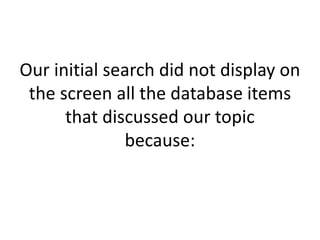Psycinfo search language_2017
- 1. Our initial search did not display on the screen all the database items that discussed our topic because:
- 2. Search Language 1. There are usually many words and phrases that could be used to describe our topic, and 2. The database search engine is °Ædumb°Ø and only searches for the words we typed. The search engine does NOT search for other words that mean the same thing as the words we used, i.e., that are synonymous with the words we used.
- 3. Search Language For example, if we were interested in children raised in single parent families, there are many ways that authors could describe that concept: single parent family one parent family motherless family fatherless family mother absent family father absent family mother absence father absence
- 4. Search Language If we had typed the phrase °∞single parent family°± the search engine result screen would NOT display items whose authors had used different terms to describe the subject
- 5. Search Language Do we, as searchers, need to be °Æword wizards°Ø to pull from our heads all the different ways our topic might be described? NO!
- 6. Search Language The way that many academic databases are put together can provide the help that all searchers can use to construct effective searches
- 7. Search Language Many organizations that produce academic databases pay people to: 1. examine every item indexed, and 2. assign subject terms that describe what each item deals with The subject terms come from a thesaurus created by each database-producing organization
- 8. Search Language ? Database producers display the subject terms from the thesaurus in each database record ? On the screen, these terms are often labeled subjects or descriptors
- 9. Subject Language ? You, the searcher, can use the displayed subject terms/descriptors to improve your database search results. HOW? 1. Look for subject terms/descriptors in each database record that are synonymous with the terms you used when you originally entered the search. 2. Then, redo the search using the database subject/descriptor terms that you found.








